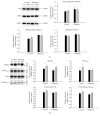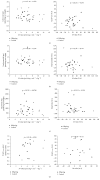Training Does Not Alter Muscle Ceramide and Diacylglycerol in Offsprings of Type 2 Diabetic Patients Despite Improved Insulin Sensitivity
- PMID: 27777958
- PMCID: PMC5061984
- DOI: 10.1155/2016/2372741
Training Does Not Alter Muscle Ceramide and Diacylglycerol in Offsprings of Type 2 Diabetic Patients Despite Improved Insulin Sensitivity
Abstract
Ceramide and diacylglycerol (DAG) may be involved in the early phase of insulin resistance but data are inconsistent in man. We evaluated if an increase in insulin sensitivity after endurance training was accompanied by changes in these lipids in skeletal muscle. Nineteen first-degree type 2 diabetes Offsprings (Offsprings) (age: 33.1 ± 1.4 yrs; BMI: 26.4 ± 0.4 kg/m2) and sixteen matched Controls (age: 31.3 ± 1.5 yrs; BMI: 25.3 ± 0.7 kg/m2) performed 10 weeks of endurance training three times a week at 70% of VO2max on a bicycle ergometer. Before and after the intervention a hyperinsulinemic-euglycemic clamp and VO2max test were performed and muscle biopsies obtained. Insulin sensitivity was significantly lower in Offsprings compared to control subjects (p < 0.01) but improved in both groups after 10 weeks of endurance training (Off: 17 ± 6%; Con: 12 ± 9%, p < 0.01). The content of muscle ceramide, DAG, and their subspecies were similar between groups and did not change in response to the endurance training except for an overall reduction in C22:0-Cer (p < 0.05). Finally, the intervention induced an increase in AKT protein expression (Off: 27 ± 11%; Con: 20 ± 24%, p < 0.05). This study showed no relation between insulin sensitivity and ceramide or DAG content suggesting that ceramide and DAG are not major players in the early phase of insulin resistance in human muscle.
Figures



Similar articles
-
Muscle-Saturated Bioactive Lipids Are Increased with Aging and Influenced by High-Intensity Interval Training.Int J Mol Sci. 2019 Mar 12;20(5):1240. doi: 10.3390/ijms20051240. Int J Mol Sci. 2019. PMID: 30871020 Free PMC article.
-
Human skeletal muscle ceramide content is not a major factor in muscle insulin sensitivity.Diabetologia. 2008 Jul;51(7):1253-60. doi: 10.1007/s00125-008-1014-z. Epub 2008 May 6. Diabetologia. 2008. PMID: 18458871
-
Effects of weight loss and exercise on insulin resistance, and intramyocellular triacylglycerol, diacylglycerol and ceramide.Diabetologia. 2011 May;54(5):1147-56. doi: 10.1007/s00125-011-2065-0. Epub 2011 Feb 17. Diabetologia. 2011. PMID: 21327867 Free PMC article. Clinical Trial.
-
Lipid-Induced Insulin Resistance in Skeletal Muscle: The Chase for the Culprit Goes from Total Intramuscular Fat to Lipid Intermediates, and Finally to Species of Lipid Intermediates.Nutrients. 2016 Jul 29;8(8):466. doi: 10.3390/nu8080466. Nutrients. 2016. PMID: 27483311 Free PMC article. Review.
-
Muscular diacylglycerol metabolism and insulin resistance.Physiol Behav. 2008 May 23;94(2):242-51. doi: 10.1016/j.physbeh.2007.12.002. Epub 2007 Dec 14. Physiol Behav. 2008. PMID: 18207474 Review.
Cited by
-
Sphingolipid Metabolism and Signaling in Skeletal Muscle: From Physiology to Physiopathology.Front Endocrinol (Lausanne). 2020 Aug 7;11:491. doi: 10.3389/fendo.2020.00491. eCollection 2020. Front Endocrinol (Lausanne). 2020. PMID: 32849282 Free PMC article. Review.
-
Association of family history of type 2 diabetes with blood pressure and resting heart rate in young normal weight Japanese women.Diabetol Int. 2021 Jul 23;13(1):220-225. doi: 10.1007/s13340-021-00525-2. eCollection 2022 Jan. Diabetol Int. 2021. PMID: 35059258 Free PMC article.
-
Insulin-Stimulated Muscle Glucose Uptake and Insulin Signaling in Lean and Obese Humans.J Clin Endocrinol Metab. 2021 Mar 25;106(4):e1631-e1646. doi: 10.1210/clinem/dgaa919. J Clin Endocrinol Metab. 2021. PMID: 33382888 Free PMC article.
-
Lipotoxicity in Kidney, Heart, and Skeletal Muscle Dysfunction.Nutrients. 2019 Jul 20;11(7):1664. doi: 10.3390/nu11071664. Nutrients. 2019. PMID: 31330812 Free PMC article. Review.
-
Mitophagy in Hepatic Insulin Resistance: Therapeutic Potential and Concerns.Front Pharmacol. 2019 Oct 10;10:1193. doi: 10.3389/fphar.2019.01193. eCollection 2019. Front Pharmacol. 2019. PMID: 31649547 Free PMC article. Review.
References
-
- Perseghin G., Scifo P., De Cobelli F., et al. Intramyocellular triglyceride content is a determinant of in vivo insulin resistance in humans: a 1H-13C nuclear magnetic resonance spectroscopy assessment in offspring of type 2 diabetic parents. Diabetes. 1999;48(8):1600–1606. doi: 10.2337/diabetes.48.8.1600. - DOI - PubMed
MeSH terms
Substances
LinkOut - more resources
Full Text Sources
Other Literature Sources
Medical

